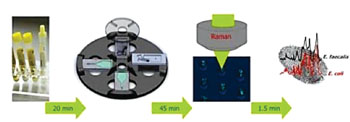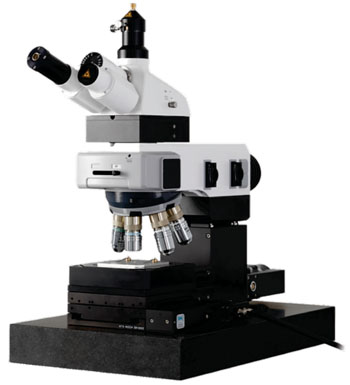Microfluidic Device Rapidly Detects Urinary Tract Infections
By LabMedica International staff writers
Posted on 24 Aug 2015
A polymeric centrifugal microfluidic platform has been developed for the rapid and sensitive identification of bacteria directly from urine, thus eliminating time-consuming cultivation steps.Posted on 24 Aug 2015
Untreated urinary tract infections can quickly move to a life-threatening condition and cases may trigger sepsis, which occurs when the immune system, in an attempt to fight off the infection, inadvertently activates body-wide inflammation that can cause blood clots and leaky blood vessels.
Scientists at the Jena University Hospital (Germany) have created a Lab-on-a-Disc platform that combines microfluidics and Raman microscopy, a modern optical detection method. The platform utilizes the rotationally induced centrifugal field to efficiently capture bacteria directly from suspension within a glass-polymer hybrid chip. Once trapped in an array of small V-shaped structures, the bacteria are readily available for spectroscopic characterization, such as Raman spectroscopic fingerprinting, providing valuable information on the characteristics of the captured bacteria.
Anonymized urine samples were provided by the hospital’s Institute of Medical Microbiology. They originated from different patients with single pathogen urinary tract infections (UTIs) of Enterococcus faecalis and Escherichia coli. To remove bigger particles such as leukocytes or epithelial cells, the urine samples were run through membrane filters, centrifuged, the pellet washed twice with phosphate buffered saline (PBS), and is finally re-suspended in PBS before being loaded into the device. A CRM 300 micro-Raman setup (WITec, Ulm, Germany), equipped with a 600 lines/mm grating was used for micro-Raman measurements.
The whole procedure, including sample preparation, requires about one hour to obtain a valuable result, marking a significant reduction in diagnosis time when compared to the 24 hours and more, typically required for standard microbiological methods. Characterization of the captured bacteria by label-free conventional micro-Raman spectroscopy allows rapid identification of the pathogens with their characteristic features, which is valuable for first screening analysis. The device has been easily adapted for fluorescence measurements, paving the way for the development of microfluidics-based immunochemical assays, illustrating a high potential of the device for numerous applications in spectroscopy-based point-of-care diagnostics.
Ulrich-Christian Schröder, a doctoral student and lead author of the study said, “Our device works by loading a few microliters of a patient's urine sample into a tiny chip, which is then rotated with a high angular velocity so that any bacteria is guided by centrifugal force through microfluidic channels to a small chamber where 'V-cup capture units' collect it for optical investigation. We were able to identify Escherichia coli and Enterococcus faecalis within 70 minutes, directly from patients' urine samples.” The study was published on August 11, 2015, in the journal Biomicrofluidics.
Related Links:
Jena University Hospital
WITec






 assay.jpg)


 Analyzer.jpg)


 (3) (1).png)


